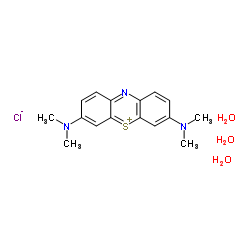7220-79-3
| Name | Methylene Blue trihydrate |
|---|---|
| Synonyms |
Phenothiazinium, 3,7-bis(dimethylamino)-, chloride, hydrate (1:1:3)
BASIC BLUE 9 HYDRATE METHYLENE BLUE TS Methylene Blue trihy MFCD00150008 EINECS 200-515-2 3,7-Bis(dimethylamino)phenothiazin-5-ium chloride hydrate (1:1:3) 3,7-bis(dimethylamino)phenothiazin-5-ium chloride hydrate(1:1:3) METHYLENE BLUE HYDRATE Methylene Blue 3,7-bis(dimethylamino)phenazathionium chloride trihydrate Methylene Blue BB 3,7-Bis(dimethylamino)phenothiazin-5-ium chloride trihydrate |
| Description | Methylene blue trihydrate (C.I. Basic Blue 9 trihydrate) is a guanylyl cyclase (sGC), monoamine oxidase A (MAO-A) and NO synthase (NOS) inhibitor. Methylene blue trihydrate is a vasopressor and is often used as a dye in several medical procedures. Methylene blue trihydrate has antinociception, antimalarial, antidepressant and anxiolytic activity effects. Methylene Blue trihydrate has the potential for methemoglobinemias, neurodegenerative disorders and ifosfamide-induced encephalopathytreatment[1][2][3]. |
|---|---|
| Related Catalog | |
| Target |
Guanylyl cyclase (sGC)[1]. Monoamine oxidase A (MAO-A)[1]. NO synthase (NOS)[1] |
| In Vitro | By acting as an alternative electron acceptor/donor Methylene blue restores mitochondrial function, improves neuronal energy production and inhibits the formation of superoxide[1]. Methylene blue inhibits cytochrome P450 (CYP) isozymes. Methylene blue is an odorless, water soluble, dark blue-green crystalline powder, which turns blue whenever mixed in solution. Methylene blue is a vasopressor that impacts the NO synthetic pathway by inhibiting inducible NOS and inhibiting the subsequent activation of sGC. In addition, by binding to the iron heme moiety of sGC and causing enzyme inhibition, Methylene blue blocks accumulation of cyclic GMP (cGMP), competing directly with NO in its ability to activate soluble guanylyl cyclase[3]. |
| In Vivo | Methylene Blue (1, 5, and 25 μg/rat) significantly decreases sevoflurane minimum alveolar anesthetic concentration (MAC) and brain cyclic guanosine monophosphate (cGMP) content in a dose-dependent manner in male Sprague-Dawley rats (7-week-old, 200-250 g)[2]. Methylene blue is used as a dye in chromoendoscopy, and is sprayed onto the mucosa of the gastrointestinal tract in order to identify dysplasia, or pre-cancerous lesions[2]. Methylene blue is able to restore vascular tone, normalize mean arterial pressures (MAP), and reduce vasopressor usage[3]. |
| References |
| Density | 0.98 g/mL at 25 °C |
|---|---|
| Melting Point | 190 °C (dec.)(lit.) |
| Molecular Formula | C16H24ClN3O3S |
| Molecular Weight | 373.898 |
| Flash Point | 14 °C |
| Exact Mass | 373.122681 |
| PSA | 75.07000 |
| Storage condition | Store at RT. |
| Stability | Stable. Incompatible with bases, reducing agents, strong oxidizing agents. |
| Water Solubility | 4 g/100 mL |
CHEMICAL IDENTIFICATION
|
| Symbol |


GHS02, GHS07 |
|---|---|
| Signal Word | Danger |
| Hazard Statements | H225-H319 |
| Precautionary Statements | P210-P280-P305 + P351 + P338-P337 + P313-P403 + P235 |
| Personal Protective Equipment | Eyeshields;Faceshields;full-face respirator (US);Gloves;multi-purpose combination respirator cartridge (US);type ABEK (EN14387) respirator filter |
| Hazard Codes | Xn:Harmful; |
| Risk Phrases | R22 |
| Safety Phrases | S26-S36-S24/25-S16-S7 |
| RIDADR | UN 1170 3/PG 2 |
| WGK Germany | 3 |
| RTECS | SP5740000 |
| Hazard Class | 6.1 |

